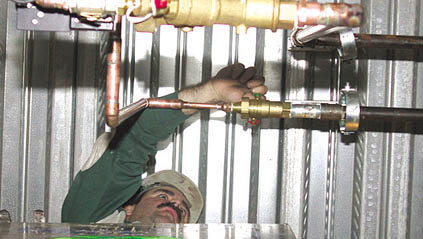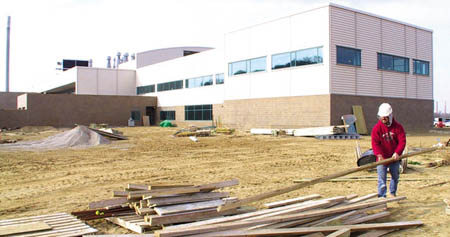Beasts of the field will get a diagnostic research center to call their own
Date Posted: November 22 2002
EAST LANSING - Animal-borne diseases like bovine tuberculosis, chronic wasting disease and the West Nile virus threaten the lives of cows, deer and humans. But state-of-the-art laboratories that have the capability of identifying, tracking and eradicating those diseases are few and far between in the U.S.
Enter the $58 million "Diagnostic Center for Population and Animal Health" under construction on the Michigan State University campus. When it becomes operational in December 2003, it will be unlike any building in the state, set up with space and mechanical fixtures to slaughter animals, rend their bodies, test blood and tissue for disease, and then incinerate the carcasses and treat body fluids so they won't pose a danger to the environment.
"The mechanical systems in this building are different from those in any other building you'll come across," said Project Manager Chuck Barnes of Granger Construction, the project's general contractor. He pointed out the conveyor system for moving carcasses, an 1,800-degree incinerator, the effluent decontamination system, a "deer-head shack" for testing for bovine tuberculosis, and even the extensive filtered ventilation and exhaust system. "It's a very interesting building," he said.
All the equipment is designed to protect researchers as they work with some of the most dangerous diseases found in nature, since it isn't clear how some maladies, like chronic wasting disease, which is killing deer in Wisconsin, affect humans.
The 152,350-square-foot building will replace and consolidate several laboratories on the campus that were established in the mid-1970s, called the Animal Health Diagnostic Laboratory. The AHDL's primary purpose was to help the state understand the cause of unprecedented deaths on cattle farms throughout Michigan. Diagnostic testing discovered that PBBs (a fire retardant chemical) had been mixed with livestock feed.
Since that time, the AHDL had become one of the country's premier and busiest diagnostic laboratories. It has grown from just over 9,700 cases when it was created to about 146,000 cases involving nearly a million tests in 1999.
The new laboratory will provide an invaluable tool in helping Michigan to identify, track, and address emerging animal and public health issues that affect pets, livestock wildlife and humans.
Work began on the building in June 2001. It will have two stories and a mechanical penthouse and will contain sophisticated bio-security equipment so researchers can work with tissue cultures and live viruses that cannot be handled safely in existing facilities anywhere in Michigan, said Dr. Willie Reed, the center's director.
"The lab has needed additional space for some time to address emerging diseases in the state," he said. "The number of tests that have been done has increased by about 60 percent in the past 10 years."
The center will also be among the few places in the nation equipped to handle pathogens, like anthrax, that might be spread by bio-terrorists.
Between 100-125 Hardhats are currently on the project. "The construction process has really gone well," Barnes said. "We've had some significant changes that were introduced into the project that have added time to the overall schedule, but we have a good team of workers and subcontractors out here who have worked together well."
While the state allocated $58 million to build the facility, legislators failed to allocated funds for operations, which are expected to cost $3 million a year. It's a higher cost than for a normal office building, because the diagnostic facility has to be operated in a "bio-secure" manner. The funding question is expected to be taken up in the legislature before the end of the year.
"The diagnostic process plays an important role in the control of animal diseases," said Lonnie King, dean of the MSU college of Veterinary Medicine. "Our farmers and pet owners deserve quick answers, and the internationally acclaimed laboratory (will) provide the best service available to all Michigan residents."

ADJUSTING a VAV box, which controls heating air volume, is Dave Kempter of UA Local 333 and John E. Green, working at the MSU Diagnostic Center.

THE LOW-TECH task of sorting scrap from forms by laborer Larry Huhn belies the high-tech nature of the interior of the Diagnostic Center for Population and Animal Health on the Michigan State campus.
